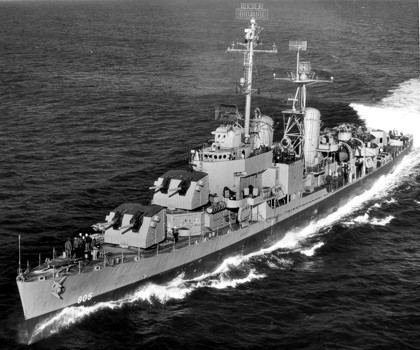

Chevalier off Norfolk, 24 May 1945, ready to deploy to the Pacific after conversion as a radar picket destroyer.
After shakedown, she was taken in hand at the Norfolk Navy Yard and converted as a radar picket destroyer before being sent to join Bath-built sisters Frank Knox, Southerland and Higbee in Destroyer Division 19 of a new Destroyer Squadron 10 in the Pacific.
Chevalier cleared Guantánamo Bay on 18 June 1945, and reached Pearl Harbor on 9 July. On the 24th, she sailed to join in the bombardment of Wake on 1 August, arriving at Eniwetok next day. She joined Task Force 38 off Honshu on 18 August, and entered Sagami Wan outside Tokyo Bay on 27 August. After patrol and escort assignments supporting occupation activities in the Marianas and Philippines, Chevalier sailed from Saipan 25 March 1946 for San Diego, arriving 11 April.
Before the Korean War, Chevalier completed tours of duty in the western Pacific in 1946–47, and 1948–49, and maintained her readiness through local operations from San Diego. On 18 March 1949, she was reclassified as a radar picket destroyer (DDR 805) and during the summer and in the fall of 1949 operated in the Hawaiian Islands.
During the Korean War, Chevalier served actively in the Far East from 6 July 1950–25 March 1951; 15 October 1951–31 May 1952: and 2 January–22 August 1953. Typically she operated in the screen of Task Force 77, the carrier force that launched almost continuous raids on Northern Korea, or on the Taiwan Strait patrol.
Chevalier’s post-war schedule alternated tours of duty with the Seventh Fleet with overhaul and training activities along the West Coast. In 1954, 1955, 1956–57, 1957–58, 1958–59 and 1960, she visited Far Eastern and Australian ports and participated in patrol duty in the Taiwan Straits and exercises off Japan, off Okinawa and in the Philippines.
On 13 July 1962, her classification reverted to DD 805. On 5 July 1972, she was transferred to South Korea, and served in the Republic of Korea Navy as ROKS Chung Buk. She was sold for scrap and dismantled in December 2000.